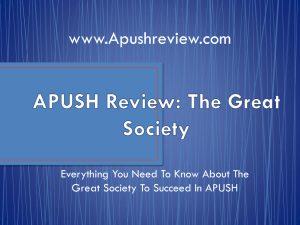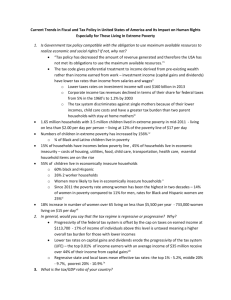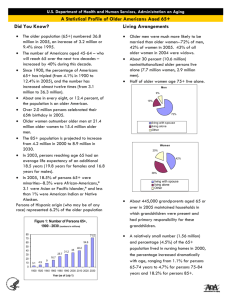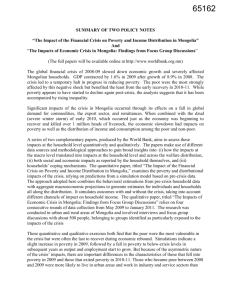Unit 4 Lesson 2 Public Goods
advertisement
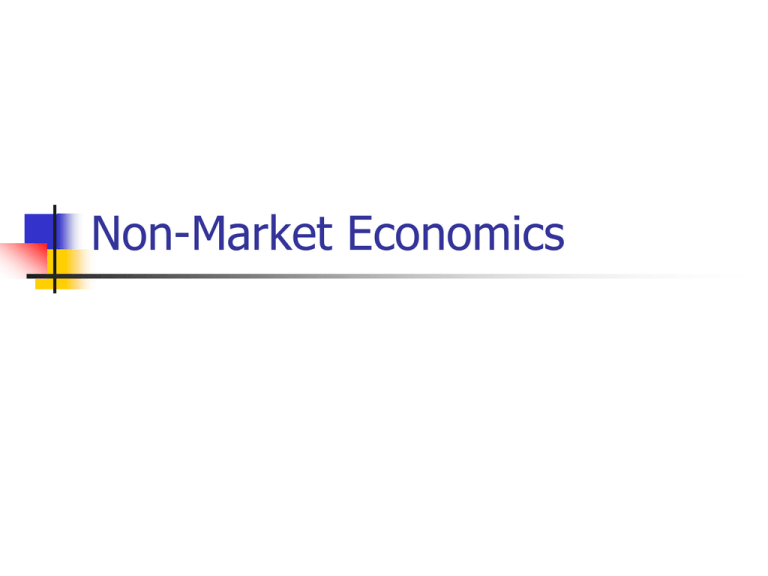
Non-Market Economics Outside the Market We have studied how consumers and firms behave in market situations: as buyers and sellers; as demanders and suppliers. There is activity that occurs outside of market situations. Sometimes this activity is referred to as Market Failure Market “Failures” 1. The Market might fail to provide certain desired goods and services 2. The Market might fail to reflect costs and benefits in the market price 3. Society might prefer a different result than the market determines Public vs. Private Goods A public good is a good that is available for everyone to consume, regardless of who pays and who doesn’t A private good is consumed by a single person or household. Definitions Public goods are: 1. “non-rival”: available to everyone to use 2. “non-exclusive”: can’t prevent “nonpayers” from consuming Private goods are; 1. “rival”: only one person can use the good 2. “exclusive”: nonpayers can be kept from consuming the good Public Goods and the Market Private companies in Alexandria, VA put out fires only of homes of those who paid for protection. A plaque was displayed by those who had paid for the protection. Public Goods Public goods are seldom provided by the modern market, since the chance for earning a profit is greatly limited Governments generally provide public goods Examples of Public Goods Public Schools Public radio Freeways – Interstate Highways Free music concert Internet National Defense Why provide public goods? Why do we have public schools? Because many groups benefit beyond the cost of providing public education: Business prefers educated workers Educated individuals earn higher incomes Government collects more taxes from workers with higher incomes Free-rider A “free-rider” is a person who gets the benefits of a public good without paying for it. Studies show that only 25% of public radio listeners actually contribute. How many of you listen to 89.7 the River? How many contributed to the fund raiser? How to fund public goods? Voluntary contributions would probably not pay for public goods like education and defense because of the free-rider problem: 1. Why pay when you can enjoy the public good for free? 2. Why pay for something you won’t use? Taxes Instead of voluntary contributions, we have given government the power to collect taxes to pay for public goods. Oliver Wendell Holmes said, “Taxes are the price we pay for a civilized society.” Public Choice Theories Some feel that government is the best tool to intervene in the economy Others oppose government intervention in the economy Arguments in favor of Gov’t Politicians must avoid extreme positions to appeal to the “median voter” Voters can “vote with their feet” and move to communities that reflect their preferences on spending and taxes Arguments against Gov’t Self Interest: 1. Voters – are ill-informed. Being an informed voter takes time, effort and money. 2. Politicians – Don’t keep promises, are only concerned with getting reelected 3. Bureaucrats – are only interested in keeping their jobs. Arguments against Gov’t Small special interest groups can manipulate government to their benefit When benefits are concentrated for only a few there is an incentive to spread the costs among many. To achieve this end, special interests use lobbyists to express views Spillover or Externalities The costs or benefits of some goods are not limited to just the producers and consumers involved in the market for these goods, they “spillover” to others. Since the costs or benefits aren’t included in the market price, they are referred to as external costs or benefits External benefits Flowers and flowering trees, that the middle school librarian enjoys as she drives past my house. Outside of the price determined by supply and demand External Costs Costs that are outside of the price determined by supply and demand. Examples might include pollution, noise pollution. Correct for Market failures Government could intervene. Establish fines for pollution Tax polluters Legal Action to sue polluters for damages Set up regulations Create pollution permits These steps INTERNALIZE the external costs, making them show up in the supply and demand graph. Complete Concrete in Elkhorn An example of government intervention External benefits Pass a law, and make violators pay a fine. Or we could subsidize, help pay for the desired product. Without Government Action Coase theorem In cases of clear property ownership, a few individuals might be able to “internalize external costs” The weedy lawn The cows and wheat. Income Distribution In our market society, income is not distributed equally among households. Is this inequality acceptable? What if anything should we do about it? Quartile Income Distribution % ‘79 ‘81 ‘83 ‘85 ‘87 ‘89 ‘91 ‘93 ‘97 2004 20 4.2 4.1 4.0 3.9 3.8 3.9 3.8 3.5 3.6 3.4 20 10.2 10.3 10.0 9.9 9.8 9.4 9.5 9.1 8.9 8.7 20 17.2 16.5 16.6 16.1 15.7 20 24.3 24.9 24.4 24.5 24.6 23.7 24.2 23.7 23.0 23.0 20 44.1 44.3 45.1 45.6 46.1 46.8 46.5 48.6 49.3 50.0 16.1 16.0 15.1 15.1 14.8 Lorenz Curve The Lorenz Curve illustrates the inequitable distribution of income See the graph on the board Poverty This unequal distribution leaves a portion of the population in poverty Poverty for a household is defined by an income below a “poverty budget” A poverty budget is based on a minimum food budget X 3. In 1999 an income below $17,029 for a family of four was considered poor 2006 HHS Poverty Guidelines Persons in Family 1 $ 9,800 2 $ 13,200 3 $ 16,600 4 $ 20,000 5 $ 23,400 6 $ 26,800 7 $ 30,200 8 $ 33,600 For each additional person, add $3,400 Inadequate Education Percentage of households with college degrees in poverty: 2.4% Percentage of households without a high school diploma in poverty: 24.1% Education and Income Gender Discrimination Racial Discrimination Single parent Two parent families in poverty: 4.8% Single parent families in poverty: 27.8% Solutions Welfare Reform? Income Redistribution Education Affirmative Action vs. “Legacies” Zero Sum Society In any policy decision there are winners and losers, just like a poker game It is important to ask “Who are the winners and who are the losers?” Cost Benefit Analysis Costs < Benefits Costs > Benefits Make the choice Don’t make the choice Basketball officials Vacation Speeding








